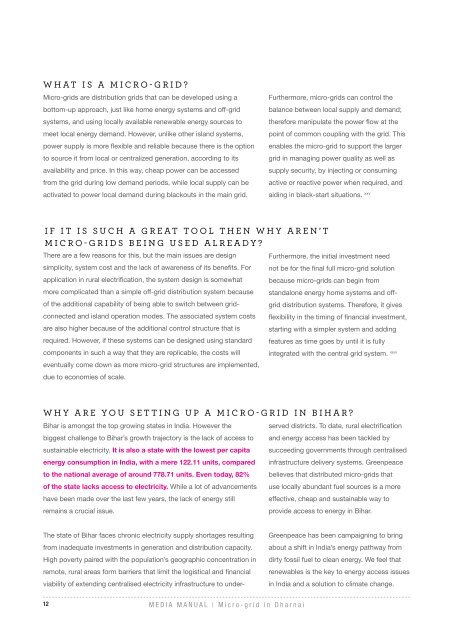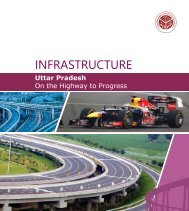media manual_low res final
media manual_low res final
media manual_low res final
Create successful ePaper yourself
Turn your PDF publications into a flip-book with our unique Google optimized e-Paper software.
What is a micro-grid?<br />
Micro-grids are distribution grids that can be developed using a<br />
bottom-up approach, just like home energy systems and off-grid<br />
systems, and using locally available renewable energy sources to<br />
meet local energy demand. However, unlike other island systems,<br />
power supply is more flexible and reliable because there is the option<br />
to source it from local or centralized generation, according to its<br />
availability and price. In this way, cheap power can be accessed<br />
from the grid during <strong>low</strong> demand periods, while local supply can be<br />
activated to power local demand during blackouts in the main grid.<br />
Furthermore, micro-grids can control the<br />
balance between local supply and demand;<br />
therefore manipulate the power f<strong>low</strong> at the<br />
point of common coupling with the grid. This<br />
enables the micro-grid to support the larger<br />
grid in managing power quality as well as<br />
supply security, by injecting or consuming<br />
active or reactive power when required, and<br />
aiding in black-start situations. xxv<br />
If it is such a great tool then why aren’t<br />
micro-grids being used already?<br />
There are a few reasons for this, but the main issues are design<br />
simplicity, system cost and the lack of awareness of its benefits. For<br />
application in rural electrification, the system design is somewhat<br />
more complicated than a simple off-grid distribution system because<br />
of the additional capability of being able to switch between gridconnected<br />
and island operation modes. The associated system costs<br />
are also higher because of the additional control structure that is<br />
required. However, if these systems can be designed using standard<br />
components in such a way that they are replicable, the costs will<br />
eventually come down as more micro-grid structu<strong>res</strong> are implemented,<br />
due to economies of scale.<br />
Furthermore, the initial investment need<br />
not be for the <strong>final</strong> full micro-grid solution<br />
because micro-grids can begin from<br />
standalone energy home systems and offgrid<br />
distribution systems. Therefore, it gives<br />
flexibility in the timing of financial investment,<br />
starting with a simpler system and adding<br />
featu<strong>res</strong> as time goes by until it is fully<br />
integrated with the central grid system. xxvi<br />
Why are you setting up a micro-grid in Bihar?<br />
Bihar is amongst the top growing states in India. However the<br />
served districts. To date, rural electrification<br />
biggest challenge to Bihar’s growth trajectory is the lack of access to and energy access has been tackled by<br />
sustainable electricity. It is also a state with the <strong>low</strong>est per capita succeeding governments through centralised<br />
energy consumption in India, with a mere 122.11 units, compared infrastructure delivery systems. Greenpeace<br />
to the national average of around 778.71 units. Even today, 82% believes that distributed micro-grids that<br />
of the state lacks access to electricity. While a lot of advancements use locally abundant fuel sources is a more<br />
have been made over the last few years, the lack of energy still effective, cheap and sustainable way to<br />
remains a crucial issue.<br />
provide access to energy in Bihar.<br />
The state of Bihar faces chronic electricity supply shortages <strong>res</strong>ulting<br />
from inadequate investments in generation and distribution capacity.<br />
High poverty paired with the population’s geographic concentration in<br />
remote, rural areas form barriers that limit the logistical and financial<br />
viability of extending centralised electricity infrastructure to under-<br />
Greenpeace has been campaigning to bring<br />
about a shift in India’s energy pathway from<br />
dirty fossil fuel to clean energy. We feel that<br />
renewables is the key to energy access issues<br />
in India and a solution to climate change.<br />
12<br />
MEDIA MANUAL | Micro-grid in Dharnai





